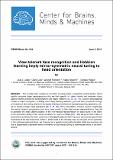| dc.contributor.author | Leibo, Joel Z. | |
| dc.contributor.author | Liao, Qianli | |
| dc.contributor.author | Freiwald, Winrich | |
| dc.contributor.author | Anselmi, Fabio | |
| dc.contributor.author | Poggio, Tomaso | |
| dc.date.accessioned | 2016-06-30T19:33:11Z | |
| dc.date.available | 2016-06-30T19:33:11Z | |
| dc.date.issued | 2016-06-03 | |
| dc.identifier.uri | http://hdl.handle.net/1721.1/103394 | |
| dc.description.abstract | The primate brain contains a hierarchy of visual areas, dubbed the ventral stream, which rapidly computes object representations that are both specific for object identity and relatively robust against identity-preserving transformations like depth-rotations [ 33 , 32 , 23 , 13 ]. Current computational models of object recognition, including recent deep learning networks, generate these properties through a hierarchy of alternating selectivity-increasing filtering and tolerance-increasing pooling operations, similar to simple-complex cells operations [ 46 , 8 , 44 , 29 ]. While simulations of these models recapitulate the ventral stream’s progression from early view-specific to late view-tolerant representations, they fail to generate the most salient property of the intermediate representation for faces found in the brain: mirror-symmetric tuning of the neural population to head orientation [ 16 ]. Here we prove that a class of hierarchical architectures and a broad set of biologically plausible learning rules can provide approximate invariance at the top level of the network. While most of the learning rules do not yield mirror-symmetry in the mid-level representations, we characterize a specific biologically-plausible Hebb-type learning rule that is guaranteed to generate mirror-symmetric tuning to faces tuning at intermediate levels of the architecture. | en_US |
| dc.description.sponsorship | This work was supported by the Center for Brains, Minds and Machines (CBMM), funded by NSF STC award CCF – 1231216. | en_US |
| dc.language.iso | en_US | en_US |
| dc.publisher | Center for Brains, Minds and Machines (CBMM), arXiv | en_US |
| dc.relation.ispartofseries | CBMM Memo Series;049 | |
| dc.rights | Attribution-NonCommercial 3.0 United States | * |
| dc.rights.uri | http://creativecommons.org/licenses/by-nc/3.0/us/ | * |
| dc.subject | Computer vision | en_US |
| dc.subject | primate visual cortex | en_US |
| dc.title | View-tolerant face recognition and Hebbian learning imply mirror-symmetric neural tuning to head orientation | en_US |
| dc.type | Software | en_US |
| dc.type | Working Paper | en_US |
| dc.type | Other | en_US |
| dc.identifier.citation | arXiv:1606.01552v1 [cs.NE] | en_US |
